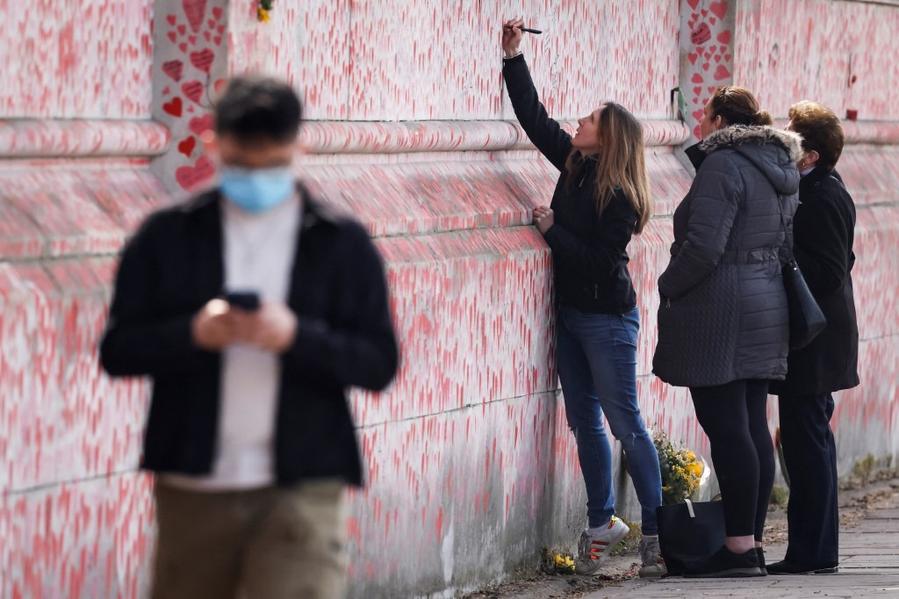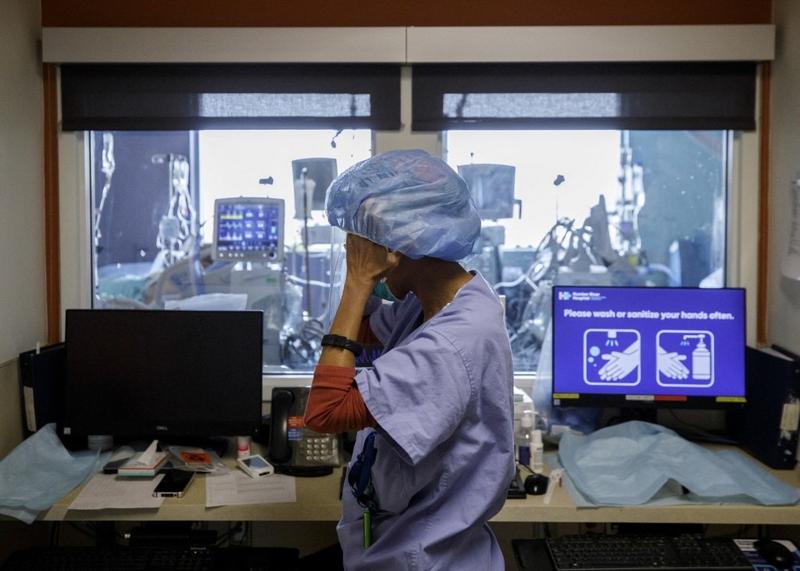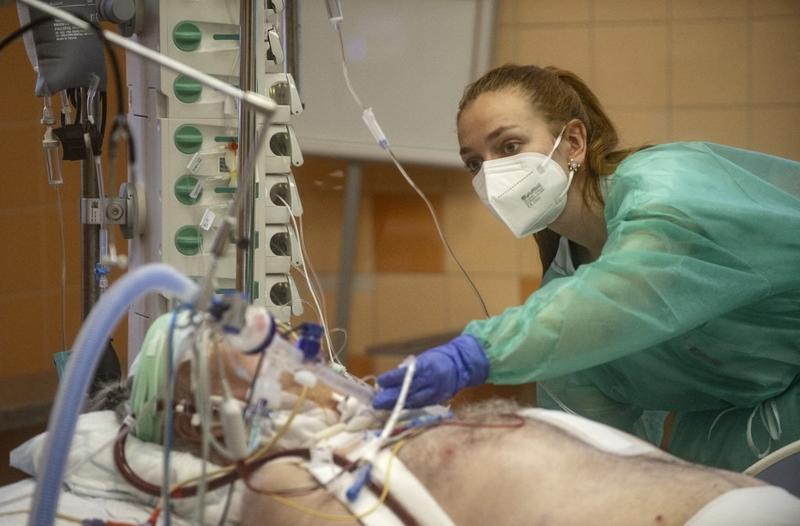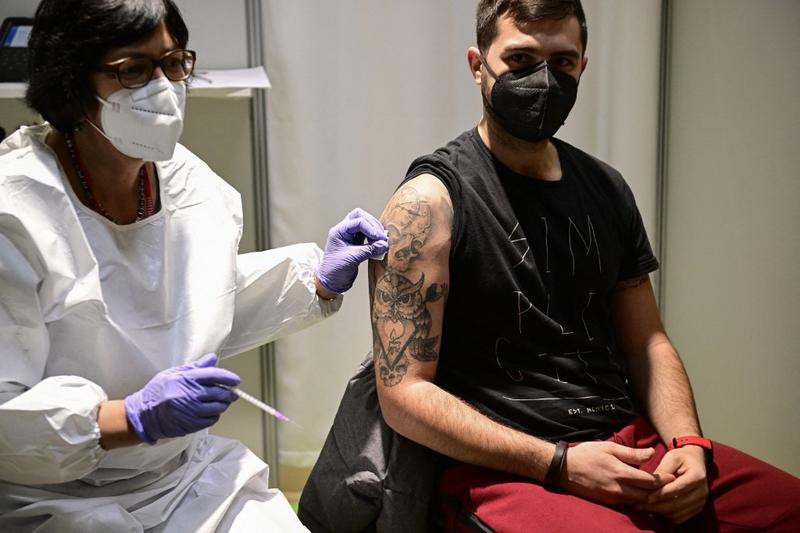 People write messages in memory of their beloved ones, on the National COVID-19 Memorial Wall, in London, on March 28, 2022. (TOLGA AKMEN / AFP)
People write messages in memory of their beloved ones, on the National COVID-19 Memorial Wall, in London, on March 28, 2022. (TOLGA AKMEN / AFP)
LONDON / NEW YORK / BERLIN / LOS ANGELES / PRAGUE / OTTAWA / WINDHOEK - An estimated 3.5 million people in Britain had COVID-19 in the latest week of available data, the Office for National Statistics (ONS) said on Friday, up nearly 30 percent on the 2.7 million recorded in the previous week.
Separately, the government announced that a new COVID booster jab program would begin later this year.
"The percentage of people testing positive for coronavirus (COVID-19) continued to increase across the UK," the ONS said. "These increases were likely caused by increases in infections compatible with Omicron variants BA.4 and BA.5."
An estimated 1 in 19 people in England were testing positive in the week to July 6, the ONS said, up from around 1 in 25 the previous week.
Scotland, whose figures were for the week to July 7, had the highest infection rate in the United Kingdom, with an estimated 1 in 16 people testing positive for COVID-19.
The government said the vaccine booster program would begin in "early autumn" and be offered to people aged 50 and over, residents and staff at care homes, individuals in clinical risk groups, people who are immunosuppressed and frontline workers.
 A healthcare worker dons a bouffant cap as staff treat patients suffering from coronavirus disease at Humber River Hospital's Intensive Care Unit, in Toronto, Ontario, Canada, on April 29, 2021. (COLE BURSTON / AFP)
A healthcare worker dons a bouffant cap as staff treat patients suffering from coronavirus disease at Humber River Hospital's Intensive Care Unit, in Toronto, Ontario, Canada, on April 29, 2021. (COLE BURSTON / AFP)
Canada
The Public Health Agency of Canada (PHAC) on Friday confirmed a total of 24,872 new cases of COVID-19 for the week of July 3 to 9, pushing the number of total cases to nearly four million.
Nationally, both COVID-19 disease activity and severity indicators have increased in recent weeks, as the BA.5 sub-lineage of Omicron predominates in more areas across Canada, Chief Public Health Officer Theresa Tam said in a statement.
The Canadian lead public health professional said that compared to prior weeks, all indicators are increasing nationally, from weekly case counts and laboratory test positivity to average daily numbers of people with COVID-19 in hospitals in Canada.
"While the precise impacts are unknown, it is reasonable to expect that we could see a continued increase in case numbers over the weeks ahead, particularly as a result the BA.5 sub-lineage of Omicron increasing in proportion among sequenced viruses," Tam said.
According to the weekly update issued by the PHAC, the number of total COVID-19 cases and deaths reached 3,978,338 and 42,148 respectively. The daily percent positive during the week averaged at 14.8 percent.
 A nurse treats a patient infected with the coronavirus in an intensive care unit (ICU) in the General University Hospital in Prague on Jan 26, 2022. (MICHEL CIZEK / AFP)
A nurse treats a patient infected with the coronavirus in an intensive care unit (ICU) in the General University Hospital in Prague on Jan 26, 2022. (MICHEL CIZEK / AFP)
Czech Republic
The Czech Republic will start administering a second booster dose of the COVID-19 vaccine from July 18, the country's health ministry announced on Friday.
The second booster dose will be available to all people over the age of 18, the ministry said in a statement. The ministry also recommended it especially to people aged over 60 and younger high-risk patients.
According to the statement, jab-seekers can get a second booster dose from Monday at vaccination sites without registration, if more than four months have passed since their last vaccination.
The ministry added that the registration system with reservation of time slots will be operating from Aug 15. "Until then, we recommend vaccination for risk groups, citizens over 60 and then for people without health problems."
The ministry also recommended the use of face masks in medical and social facilities, in public transport and places with a large concentration of people.
Daily COVID-19 infections in the Czech Republic started to rise at the end of June mainly due to the more contagious Omicron subvariants BA.4 and BA.5.
On Monday, the country recorded more than 2,000 new cases for the first time since late April. COVID-19 hospitalizations also continued to rise, reaching 413 on Thursday, compared with 315 a week ago.
 A young man receives the Nuvaxovid vaccine against COVID-19 coronavirus, at the CIZ Tegel vaccination center in Berlin, on Feb 28, 2022. (TOBIAS SCHWARZ / AFP)
A young man receives the Nuvaxovid vaccine against COVID-19 coronavirus, at the CIZ Tegel vaccination center in Berlin, on Feb 28, 2022. (TOBIAS SCHWARZ / AFP)
Germany
Germany's Minister of Health Karl Lauterbach on Friday recommended a fourth COVID-19 vaccine dose for people under the age of 60, contradicting the advice from a relevant national commission.
Germany's Standing Committee on Vaccination (STIKO) recommends a second COVID-19 booster shot with a mRNA vaccine, such as the Pfizer/BioNTech or Moderna, only to people aged over 70, residents in care facilities, people with immunodeficiency and medical staff.
A vaccine adapted to Omicron is expected to come out in late August or early September, but Lauterbach said people who are aged 60 and over "should definitely not wait for the new vaccine," as the protection they need against serious illness or death is already provided by the current vaccines.
Of the 69.4 million adults in Germany aged 18 and older, around 85 percent are vaccinated against COVID-19. About 72 percent have received one booster vaccination, while almost 9 percent have received two booster doses, according to official figures.
The country's seven-day COVID-19 incidence rate on Friday stood at around 720 infections per 100,000 inhabitants, after around 700 last week, according to the Robert Koch Institute (RKI) for infectious diseases.
Since the beginning of June, the number of cases has been rising steadily. "We will have a very difficult fall," Lauterbach warned.
Namibia
Namibian President Hage Geingob Friday announced that all restrictions imposed on the COVID-19 pandemic were removed.
Geingob was speaking during the country's 45th COVID-19 public briefing, where he also said the government would intensify its vaccination campaign.
"We believe that vaccination is necessary to protect the nation against any outbreak of new variants of COVID-19," he said.
In addition, foreign travelers are required to present vaccination certificates at point of entry, similar to the requirement for travelers to produce certificates of vaccination against Yellow Fever in some countries.
Geingob stated that the control of COVID-19 would be carried out in the same way as was for Hepatitis E.
 A person receives a COVID-19 test out of a mobile testing van on Jan 5, 2022 in New York City. (ANGELA WEISS / AFP)
A person receives a COVID-19 test out of a mobile testing van on Jan 5, 2022 in New York City. (ANGELA WEISS / AFP)
United States
US Black, Latino and American Indian persons experienced higher rates of COVID-19 infection, hospitalization and death than white, non-hispanic persons, reported Forbes this week.
"Genetic predisposition to health conditions like lung disease and hypertension contribute to these numbers, but greater still are the societal factors which influence these statistics," the report showed.
Marginalized groups are more likely to live and work in crowded settings and to have less income and wealth. As a result these groups were, and still are, more likely to catch COVID-19 than others, but are less equipped to face the economic strain which accompanies testing, treatment and recovery, according to the report.
The current state of the pandemic, now two and a half years in progress, has left at least 20 million people as COVID-19 survivors in the United States facing post-COVID Conditions, otherwise known as Long COVID-19, it said.
"While it is uncertain whether people of diverse backgrounds have higher genetic risk of developing the condition, communities of color will likely face exacerbated effects of Long COVID-19 as a consequence of persisting health inequities," it added.


